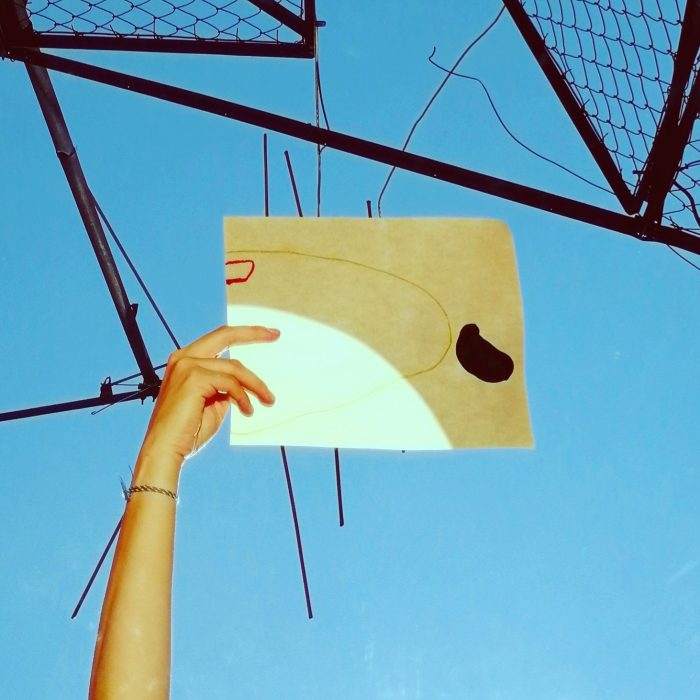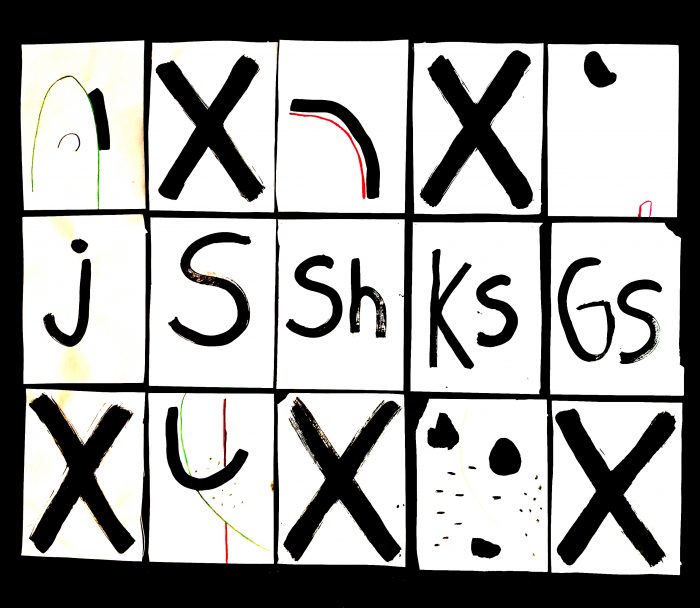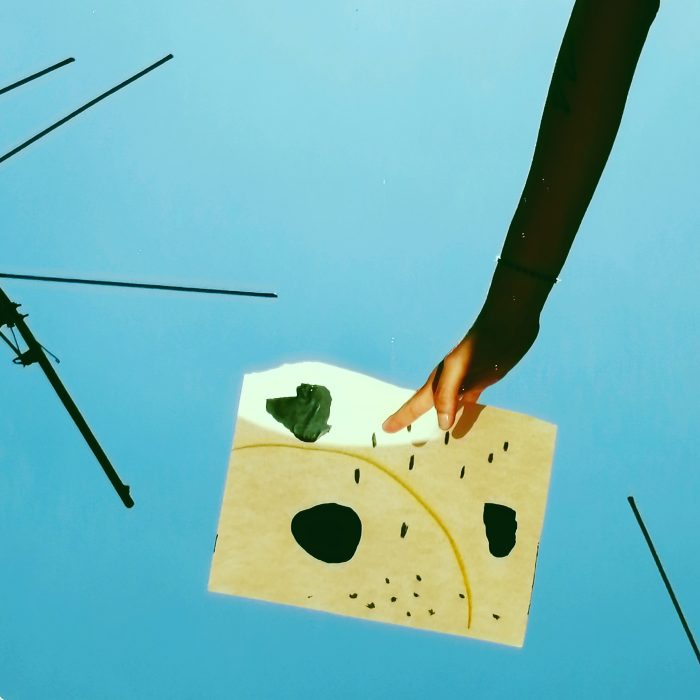
29.06.2020
From the reformulations of the body in times of a pandemic, the researcher Valeria Montoya explores the traceable links between the personal and the common to rethink, from what separates us and from the body itself, how we articulate multiplicities shaped from difference.

A particle travels, its speed fast. The light that comes out of it, due to the collision with other atoms, makes this traveling particle acquire a halo of light with shining colors: blue, orange, red, silver, gold, and also the rest of the colors that our human eyes cannot see. It has an aerodynamic and metallic sound.
meta (from the Greek: movement).
Movement, continuous migration, unstoppable. Movement, insatiable hunger for glucose. Two, four, eight, sixteen, thirty-two. The rhythm of the division of pairs, which four million years ago determined the structure of every microbe, and of every inhabitant on this planet. The rhythm also becomes the structure of grass, air, as well as marine, land, and air creatures. The structure and rhythm of everything that is vital, and also of everything that starts with a process of organic transformation.
As I line up at the supermarket, I stand on top of an X made of plastic, like industrial tape. The ribbon has the width of my hand, and its color is a phosphorescent yellow, I love it! In the middle of the intersection of the two lines that make up the X, right at that midpoint of an intersection, I find myself fascinated and entertained. I put my feet in the middle and wait to pay for my purchase. I feel the presence of my body, my neck gets longer and my feet stick to the ground. I feel the gravity of the planet in my own weight and I also notice the presence of the people in front of and behind me.
From this body, which I have already reconstructed so many times, what resistance will I have to integrate now?
Today there is a two-meter gap between harmlessness and harmfulness. I sense the space between us, the “intermediate”, the in-between us. In relatively few days I have learned to inhabit and move my own body with other gestures. My movements, and the somatic relations with the space that flow from it, are limited but diverse. I become aware of my body’s borders on the spatial experience of public space while trying to understand my own movements; and, on the contrary: my movements, sometimes clumsy, try to understand this new logic around public space. It’s almost like inventing a language or learning a new one amidst the confusion on the physical scale of the body. The power of the number ten generously embraces the relativity of the size of things.
What narratives begin to nourish the spaces and borders between the people that are waiting with me in line to pay at the supermarket? From this body, which I have already reconstructed so many times, what resistance will I have to integrate now?

A score, or command among movement practitioners, is a basic rule of the game. Somewhat like a starting point to begin moving, it can also be a point of continuity to be tracked. This is the story of the X in which I find myself standing today, it is a story that is narrated in the supermarket line, in manifests of companion species,[1] in music transmitted by satellites, and in the sound of the birds that I did not hear before. This X today is my main score, I float on it, and I also anchor myself on it until I know what next step I must take.
Every species on Earth has a certain number of X’s, an internal compact writing. A kind of travel log which, generation after generation, is updated and reported. Twenty-three pairs of Xs inhabit each human on Earth, and each of them is the product of an abundant mix of genetic information, the consequences of which are made into a body.
The twenty-fifth letter of the Spanish alphabet is possibly the most ambiguous letter for me. This X is adapted depending on who you are with, in front of or behind it. It does not distinguish between plural or singular grammar and has five sounds: Sh /Ks/ Gs/J, even just: S. Reading about biology and linguistics, I discovered that the word metaplasm also means a change in the composition of a word. Metaplasms are the transformations that are made in some words due to random or intentional contraction. Metaplasm is also an adaptive mechanism, which sometimes, in the field of medicine, can be considered a premalignant lesion. But this reaction occurs mainly and almost always as a mechanism that will try to reverse the cessation of an aggressive stimulus.
Multiple corporeal and spatial topologies can be felt from a confined world, but I like to believe that confinement is not separatist. Beneath the pores of my skin, and also yours, there is information that you share with another being on this planet.
In a world of prisons, this X tries to narrate itself without preconceived objects and subjects, no matter how much each X contains in its genetic material. It is a story that is told without unique sources, without genre, ambiguous in its pronunciation. Also included in pre-colonial languages, this X moves and transforms. She is a fugitive, and her only permanence is in the movement she makes while walking.

Multiple corporeal and spatial topologies can be felt from a confined world, but I like to believe that confinement is not separatist. Beneath the pores of my skin, and also yours, there is information that you share with another being on this planet. Your biomolecular inheritance is the changing genetic narrative, that like a matryoshka it embraces a package of X: chromosomes, which become larger than any ideology about difference, and yet define you, but also accompany you and someone else outside of you.
Kinship for Donna Haraway is to go against Oedipus, it is to learn to relate to the rest of things, technologies, people, human and non-human agents, that do not necessarily share our same codes of X. Kinship is breaking away from the familiar, to twin with otherness. To make a herd. To be a herd.
Otherness becomes generous, and a difficult task to embrace in a world with such structured boundaries: ideals and assumptions that will try to erase the sensous knowledge[2] that is in the poetics and holistic approach[3] of everyday life as vital energy, from its synergistic effects. This institutionalization of what affects us will try to deprive us of the imaginative possibilities of our living together on this planet.
Our bodies, maps of power and identity,[4] territories of life and death, must now, more than ever, be able to embrace difference, to relate to the rhythm of the other, and to be oneself with all the other elements that coexist here and now.
COVID-19 could be part of the evolution of the whole planet, not even just man as a species. Although for humans, it has brought a whole new set of codes of sociability, policies of difference, and mobility. This historical moment of which we are a part goes beyond science fiction. Urgency cannot be postponed, it is a good moment to think about ourselves from other narratives, and to learn generously that our body, also a particle that travels, unites with others and it is in that movement that we must learn to dance to the rhythm of multiplicity.
Donna Haraway, The Companion Species Manifesto (Chicago: Prickly Paradigm Press, 2015)
Minna Salami, Sensuous Knowledge (Londres: ZED Books, 2020)
Words as “whole”, “entirety”, “totality” represent a methodological and epistemological position that states how systems (whether physical, biological, social, economic, mental, linguistic, etc.) and their properties should be analyzed as a whole and not just through the parts that make them up.
Donna Haraway, Cyborg Manifesto (Minnesota: University of Minnesota Press, 2016), p.65
Comments
There are no coments available.